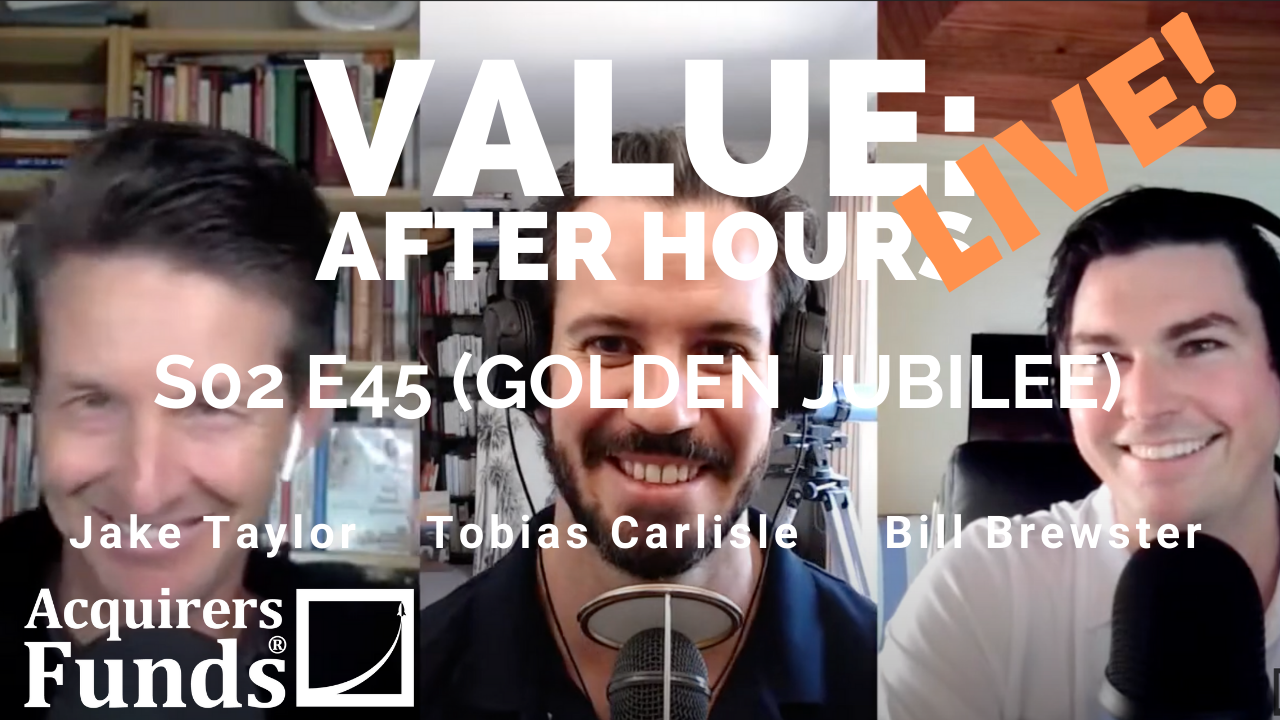During their recent episode of the VALUE: After Hours Podcast, Taylor, Brewster, and Carlisle discussed Archery vs Darts. Here’s an excerpt from the episode:
Jake: Okay, so Annie Duke’s new book that just came out. It’s called How to Decide. And in there, she’s talking about having an archer’s mindset. And what she’s getting at is that it really pays to focus on aiming for that bullseye because even if you miss a little bit, you’re going to hit a decent score. And so, she says, “Just like in decision-making, archery is not all or nothing, where you get points only for hitting the bullseye and everything else is a miss. An archer gets points for hitting the target at all.”
Okay, so if I think about that mindset kind of applied to investing, you might end up saying, “Gosh, if I can just find the next Amazon or Google and it’s even one-tenth as good as those turned out, it’s going to be a monster home run for me.” So, I’m aiming for that bullseye of the monster compounder, super compounder. And even if I’m close, I’m going to get a really good outcome. Now, something like Snowflake comes to mind a little bit where it’s like, you ask, “Is it going to be bigger in 10 years from now?” Yeah, I probably, but it better be at a $68 billion valuation, it needs to be incredibly bigger.
I think what’s interesting is asking yourself is investing like archery, like Annie’s talking, or is it more like darts. In Rory Sutherland’s book, Alchemy, he talks about different scoring systems. One of them is darts where it doesn’t always pay to go for the single highest score. So, in this instance, if you look at a dartboard, the 20 at the top is what the pros aim for. They’re trying to hit the triple 20 most of the time, but on either side of that is 1 and 5. And if you miss, you’re going to end up hitting a relatively low score. The average of those three slices on a dartboard is 8.7.
Now, if you look at the southwest quadrant of a dartboard, you get the numbers 16, 7, and 19 together, and the average of those three is actually 14. So, not quite double, but almost double. If you were to miss it all, you end up potentially with not a bad outcome. So, ironically, you almost want to aim for the 7 and hope to hit either a 16 or a 19.
Now, Patrick O’Shaughnessy in 2014 wrote this pretty good piece about lottery stocks. These were typically some new innovation or technology or something revolutionary that captures the imagination, and they tend to be in the 10% highest price to sales, price to cash flow, price to earnings. They tend to skew towards biotech and pharma and technology software. And you have these very, very big outcomes out of that group.
Tobias: That’s what keeps people hunting in the expensive stuff.
Jake: That’s what keeps them going is these lottery type of outcomes. He updated the piece in 2015 with a really nice note called Lessons from Market Extremes. What he found was that when you look at that basket of the glamour stocks, they contain the highest outcome, like outcome stocks, they’re these giant winners. They’re hitting that 20 on the dartboard. The best performing of those glamour stocks, put up a, let’s see, plus 112% on average. However, the median of them underperformed by 11%. So, if we’re throwing the dart, we’re likely to get that 11% underperformance and not necessarily that huge 118% outperformance winner.
Bill: I don’t know that I agree with this, I’m just going to pin that. Continue.
Jake: Okay.
[laughter]Jake: Thank you for that.
Tobias: Well, just before you go on, isn’t that Partha Mohanram who I talked to on the podcast, he’s the guy who had– I’m now blanking a little bit on what his score is, but he was like– he saw the F-score and said–
Jake: G-score or something?
Tobias: That’s right. Growth score, that’s right. And so, his idea was apply the F-score in the really expensive stocks and then– he told me in the podcast that it’s a pretty good performer, it outperforms, it outperforms the market, outperforms that cohort of stocks. But the way that it does it, for the most part, is it shorts the stuff that falls– so it’s the short side that generates the returns rather than the long side. But then, you also have the nice benefit over the last few years, of course, that it’s been the long side that’s generated the return. So, I was alerted to that strategy by the Validea guys and they pointed out that it had been the best performance strategy of all the strategies that they tracked for the last few years. So, it’s a good strategy, anti-value.
Jake: Yeah. So, if you look at the value segment, which to me, represents the southwest quadrant of the dartboard, the best performing of that group was a plus 76%, which is pretty good, but not nearly as good as the 112% of the other. But the median was an outperformance of 5.4%. So, that’s sort of like missing on the dartboard but getting a decent outcome. Something to think about, if you are an incredible dart thrower, a professional, maybe you have a shot at just ringing up the triple 20s, but I’m a little bit pessimistic that there are as many good dart throwers out there as maybe think that they are at this point. So, maybe be a little bit more intellectually humble, realize that you’re going to miss on the dartboard, and aim for places that can lead to maybe tighter dispersion of outcomes, but a more positive expected value.
Tobias: Yeah, I like that.
Bill: I don’t know that I agree. Here’s the thing. I’ve sort of talked about it with the David Gardner thing. If your definition of value is a stock that could rerate and double– this sort of goes into what I hate about myself, so I’ll just use this example. Spirit AeroSystems is a good example of something that I wrote on my blog recently. And the thing about owning that company is it’s not a compounder in the sense that you could just own it forever. Eventually, I would need to sell it. I truly believe it was too cheap. I don’t know what exactly the right price target is. I mean, I don’t actually believe in myself to have that kind of precision. I think I’m reasonably good at knowing when things are cheap. I don’t think I’m very good at knowing when things should be sold.
In that game, I’m basically betting on a rerating where I think I have to use what I perceive myself to be weakest at to exploit the advantage because I don’t want to own the company forever. So I’m selling and then paying tax, where I think that there’s some genius in what the David Gardner philosophy is, yeah, maybe my probability of zero is higher or probability of a bad outcome is higher in some of these traditionally higher-valued stocks. But if I spray enough of these bullets, the right tail is going to take me out of that. I can overcome that hurdle if I truly can hold it. And I just think it’s a matter of personality–
Jake: The analogy would be that it’s not a 20, it’s a 200 on the dartboard.
Bill: Yeah, because I think some of these value stocks that people– I shouldn’t say people– that I used to look at, have a truncated upside, and that I think can skew the set of probabilities quite a bit. Whereas– like I was reading CrowdStrike’s 10K today and back in the day, I was talking to somebody who has like employed 9 to 11 or something like that. He doesn’t work anymore. But he said– he was like, “They’re going to win. It’s inevitable.” And today, when I was reading the 10K, I was just sort of processing what he was saying while I was reading it– I think people should read that 10K. And is it buying today? I don’t have any clue. I don’t have any view on that. What I do know is, I don’t think that that valuation is patently absurd if you have the view that it’s inevitable, and you believe what the 10K says. So, those questions have to be answered. And I don’t know how many of these companies are that way or whatever.
To your point, the valuation’s imply inevitability on a lot of these things. But I used to think that bucket was really stupid deficient. I think it’s probably stupid for the average person to make concentrated bets in, but I don’t know that I agree that it’s a bad place to fish forever. These valuations are really demanding.
You can find out more about the VALUE: After Hours Podcast here – VALUE: After Hours Podcast. You can also listen to the podcast on your favorite podcast platforms here:
For all the latest news and podcasts, join our free newsletter here.
Don’t forget to check out our FREE Large Cap 1000 – Stock Screener, here at The Acquirer’s Multiple:




